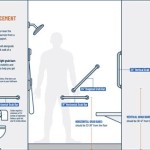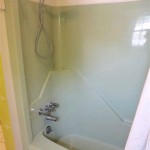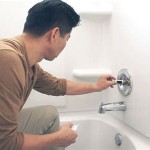Can You Sleep In The Bathtub? Exploring the Risks and Realities
The question of whether one can sleep in the bathtub is not merely a matter of curiosity. It touches upon issues of safety, hygiene, comfort, and even survival in extreme circumstances. While scenarios might exist where sleeping in a bathtub seems like a reasonable option, there are significant risks and considerations that necessitate a thorough understanding of the potential consequences.
The allure of a bathtub as a sleeping space might stem from a perceived sense of security, particularly during emergencies. The hard, enclosed structure offers a rudimentary form of protection against debris or intrusion. However, this perceived safety must be weighed against the inherent dangers associated with prolonged periods of immobility and exposure to the specific environment the bathtub presents.
This article will explore the potential dangers and practicalities of sleeping in a bathtub, examining the health risks, hygiene concerns, and alternative solutions that should be considered whenever possible. We will delve into the specific situations where this might be considered, emphasizing the precautions necessary to mitigate the risks, should such a decision be unavoidable.
Hypothermia and Thermal Regulation
One of the most significant risks associated with sleeping in a bathtub, even if it is dry, is the potential for hypothermia. Bathtubs are typically made of materials such as porcelain, acrylic, or cast iron, all of which conduct heat efficiently. This means that the bathtub will rapidly draw heat away from the body, even at room temperature. This heat loss can be exacerbated by the presence of even small amounts of water, as water conducts heat far more effectively than air. Prolonged exposure to this cooling effect can lead to a dangerous drop in body temperature, resulting in hypothermia.
Hypothermia occurs when the body loses heat faster than it can produce it, leading to a dangerously low body temperature. Symptoms of hypothermia can range from shivering and confusion to loss of coordination and eventually, unconsciousness. In severe cases, hypothermia can be fatal. The risk is particularly acute for vulnerable populations such as the elderly, infants, and individuals with pre-existing medical conditions.
Even in warmer climates, the evaporative cooling effect of sweat on the skin can contribute to heat loss within the bathtub environment. The lack of insulation and the typically cool surface of the bathtub can create a microclimate that promotes heat dissipation from the body. Therefore, it is crucial to understand the environmental conditions and take appropriate measures to insulate the body when considering sleeping in a bathtub.
Mitigation strategies include using blankets, towels, or even clothing to create a barrier between the body and the bathtub surface. Layers of insulation can help to trap body heat and reduce the rate of heat loss. If water is present, it must be completely drained and the bathtub thoroughly dried before attempting to sleep in it. Monitoring body temperature and being alert to the early signs of hypothermia are also essential.
Hygiene and Infection Risks
The bathtub is inherently a location associated with hygiene. While cleaning is expected, the environment is conducive to bacterial growth and the potential for infection. Even after thorough cleaning, trace amounts of bacteria, fungi, or other microorganisms can remain on the surfaces of the bathtub. These microorganisms can multiply rapidly in the presence of moisture and warmth, creating a breeding ground for potential infections.
Sleeping in a bathtub exposes the body to these microorganisms for an extended period, increasing the risk of skin infections, respiratory problems, or other illnesses. Individuals with weakened immune systems are particularly vulnerable to these types of infections. Furthermore, the bathtub environment can be dusty and may contain allergens that can trigger allergic reactions or exacerbate existing respiratory conditions such as asthma.
The lack of proper ventilation in many bathrooms can also contribute to the buildup of moisture and humidity, further promoting microbial growth. This can lead to the development of mold or mildew, which can pose significant health risks, particularly for individuals with sensitivities to mold or pre-existing respiratory conditions. Prolonged exposure to mold spores can trigger allergic reactions, asthma attacks, or even more serious respiratory illnesses.
To mitigate these hygiene risks, it is essential to thoroughly clean and disinfect the bathtub before attempting to sleep in it. Using a strong disinfectant and ensuring proper ventilation can help to reduce the number of microorganisms present and minimize the risk of infection. Additionally, using a clean barrier, such as a sheet or blanket, between the body and the bathtub surface can help to further reduce exposure to potential contaminants. Personal hygiene practices, such as showering or bathing before sleeping in the bathtub, are also crucial to minimize the risk of infection.
Circulation and Mobility Issues
Prolonged immobility in the confined space of a bathtub can lead to significant circulation problems and mobility issues. The limited space restricts movement and can cause pressure points on the body, particularly on bony prominences such as the hips, shoulders, and heels. These pressure points can compromise blood flow to the surrounding tissues, leading to discomfort, pain, and eventually, tissue damage.
Prolonged pressure on these areas can result in pressure ulcers, also known as bedsores. These ulcers occur when sustained pressure cuts off blood supply to the skin and underlying tissues, causing them to break down. Pressure ulcers can be extremely painful and can take a long time to heal. Individuals with pre-existing medical conditions such as diabetes or poor circulation are at a higher risk of developing pressure ulcers.
Additionally, the cramped position often adopted when sleeping in a bathtub can restrict blood flow to the extremities, leading to numbness, tingling, or even pain in the hands and feet. This can be particularly problematic for individuals with pre-existing circulatory problems. Furthermore, prolonged immobility can increase the risk of developing blood clots in the legs, a condition known as deep vein thrombosis (DVT). DVT can be a life-threatening condition if the blood clot breaks loose and travels to the lungs, causing a pulmonary embolism.
To mitigate these circulation and mobility issues, it is essential to change position frequently while sleeping in the bathtub. This can help to relieve pressure on bony prominences and promote blood flow to the tissues. Using pillows or towels to cushion pressure points can also be helpful. Regular stretching and light exercise can help to improve circulation and reduce the risk of blood clots. If possible, getting up and walking around periodically is also recommended.
Furthermore, consider the mental and emotional state of someone forced to sleep in such a confined and uncomfortable space. Anxiety, stress, and fear can exacerbate the physical discomfort and potentially lead to panic or claustrophobia. Mental health considerations are crucial in assessing the feasibility and safety of this course of action.
In conclusion, while sleeping in a bathtub may seem like a viable option in certain emergency situations, it is crucial to be aware of the potential risks and take appropriate measures to mitigate them. Hypothermia, hygiene concerns, and circulation problems are all significant dangers that need to be addressed. By understanding these risks and implementing appropriate precautions, it may be possible to minimize the potential harm and ensure a safer outcome.

How To Sleep In A Bathtub 9 Steps With Pictures Wikihow

But The Bathtub Is Comfortable Tiny House Blog

How To Sleep In A Bathtub 9 Steps With Pictures Wikihow

Is Sleeping In The Bath Dangerous Bed Consultant

How To Sleep In A Bathtub 9 Steps With Pictures Wikihow

Do Not Sleep In Water Overnight

This Kind Of Bath Can Give You The Best Sleep Ever Study

Taking A Bath At This Exact Temperature Time Will Help You Sleep Like Baby

How A Hot Tub Can Help You Sleep Thermospas

Could A Bath 90 Minutes Before Bedtime Help You Get Better Night S Sleep Go Express
Related Posts








